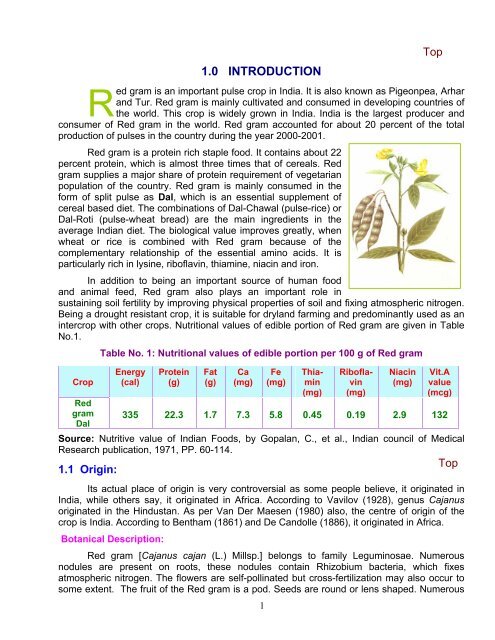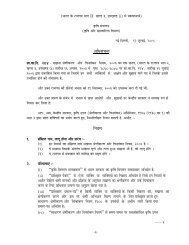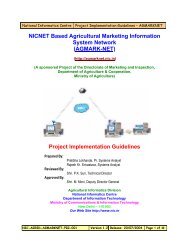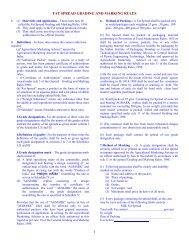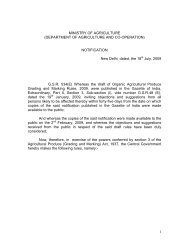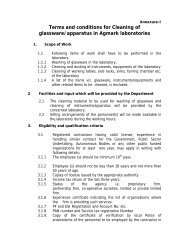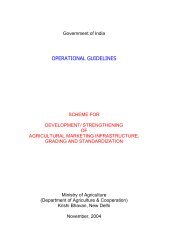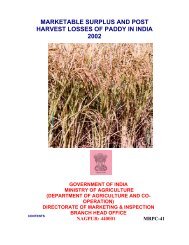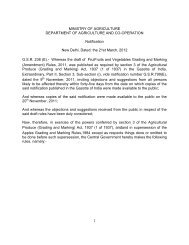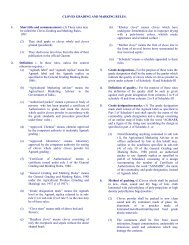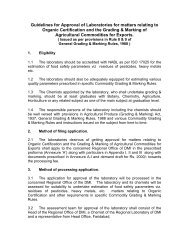Post-harvest profile of red gram - Agmarknet
Post-harvest profile of red gram - Agmarknet
Post-harvest profile of red gram - Agmarknet
Create successful ePaper yourself
Turn your PDF publications into a flip-book with our unique Google optimized e-Paper software.
R1.0 INTRODUCTIONed <strong>gram</strong> is an important pulse crop in India. It is also known as Pigeonpea, Arharand Tur. Red <strong>gram</strong> is mainly cultivated and consumed in developing countries <strong>of</strong>the world. This crop is widely grown in India. India is the largest producer andconsumer <strong>of</strong> Red <strong>gram</strong> in the world. Red <strong>gram</strong> accounted for about 20 percent <strong>of</strong> the totalproduction <strong>of</strong> pulses in the country during the year 2000-2001.Red <strong>gram</strong> is a protein rich staple food. It contains about 22percent protein, which is almost three times that <strong>of</strong> cereals. Red<strong>gram</strong> supplies a major share <strong>of</strong> protein requirement <strong>of</strong> vegetarianpopulation <strong>of</strong> the country. Red <strong>gram</strong> is mainly consumed in theform <strong>of</strong> split pulse as Dal, which is an essential supplement <strong>of</strong>cereal based diet. The combinations <strong>of</strong> Dal-Chawal (pulse-rice) orDal-Roti (pulse-wheat bread) are the main ing<strong>red</strong>ients in theaverage Indian diet. The biological value improves greatly, whenwheat or rice is combined with Red <strong>gram</strong> because <strong>of</strong> thecomplementary relationship <strong>of</strong> the essential amino acids. It isparticularly rich in lysine, rib<strong>of</strong>lavin, thiamine, niacin and iron.In addition to being an important source <strong>of</strong> human foodand animal feed, Red <strong>gram</strong> also plays an important role insustaining soil fertility by improving physical properties <strong>of</strong> soil and fixing atmospheric nitrogen.Being a drought resistant crop, it is suitable for dryland farming and p<strong>red</strong>ominantly used as anintercrop with other crops. Nutritional values <strong>of</strong> edible portion <strong>of</strong> Red <strong>gram</strong> are given in TableNo.1.CropRed<strong>gram</strong>DalTable No. 1: Nutritional values <strong>of</strong> edible portion per 100 g <strong>of</strong> Red <strong>gram</strong>Energy(cal)Protein(g)Fat(g)Ca(mg)Fe(mg)Thiamin(mg)Rib<strong>of</strong>lavin(mg)Niacin(mg)Vit.Avalue(mcg)335 22.3 1.7 7.3 5.8 0.45 0.19 2.9 132Source: Nutritive value <strong>of</strong> Indian Foods, by Gopalan, C., et al., Indian council <strong>of</strong> MedicalResearch publication, 1971, PP. 60-114.1.1 Origin:Its actual place <strong>of</strong> origin is very controversial as some people believe, it originated inIndia, while others say, it originated in Africa. According to Vavilov (1928), genus Cajanusoriginated in the Hindustan. As per Van Der Maesen (1980) also, the centre <strong>of</strong> origin <strong>of</strong> thecrop is India. According to Bentham (1861) and De Candolle (1886), it originated in Africa.Botanical Description:Red <strong>gram</strong> [Cajanus cajan (L.) Millsp.] belongs to family Leguminosae. Numerousnodules are present on roots, these nodules contain Rhizobium bacteria, which fixesatmospheric nitrogen. The flowers are self-pollinated but cross-fertilization may also occur tosome extent. The fruit <strong>of</strong> the Red <strong>gram</strong> is a pod. Seeds are round or lens shaped. Numerous1


